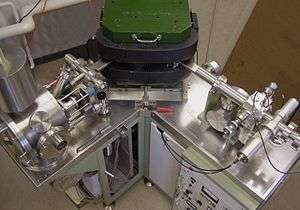Isotope fractionation

Isotope fractionation describes processes that affect the relative abundance of isotopes, often used in isotope geochemistry. Normally, the focus is on stable isotopes of the same element. Isotopic fractionation in the natural environment can be measured by isotope analysis, using isotope-ratio mass spectrometry, to separate different element isotopes on the basis of their mass-to-charge ratio, an important tool to understand natural systems. For example, in biochemistry processes cause a fluctuation in the amount of carbon isotope ratios incorporated into a biological being. The difference between the true amount of carbon and the amount in the plant is known as isotope fractionation.
Definition
Stable isotopes partitioning between two substances A and B can be expressed by the use of the isotopic fractionation factor (alpha):
αA-B = RA/RB
where R is the ratio of the heavy to light isotope (e.g., 2H/1H or 18O/16O. Values for alpha tend to be very close to 1.[1]
Types
There are four types of isotope fractionation, of which the first two are normally most important:
- Equilibrium fractionation
- Kinetic fractionation
- Mass-independent fractionation (or Non-mass-dependent fractionation)
- Transient kinetic isotope fractionation
Example
Isotope fractionation, occurs during a phase transition, when the ratio of light to heavy isotopes in the involved molecules changes. When water vapor condenses (an equilibrium fractionation), the heavier water isotopes (18O and 2H) become enriched in the liquid phase while the lighter isotopes (16O and 1H) tend toward the vapor phase.[1]
References
- 1 2 Carol Kendall (2004). "Fundamentals of Stable Isotope Geochemistry". USGS. Retrieved April 10, 2014.
- Faure G., Mensing T.M. (2004), Isotopes: Principles and Applications (John Wiley & Sons).
- Hoefs J., 2004. Stable Isotope Geochemistry (Springer Verlag).
- Sharp Z., 2006. Principles of Stable Isotope Geochemistry (Prentice Hall).